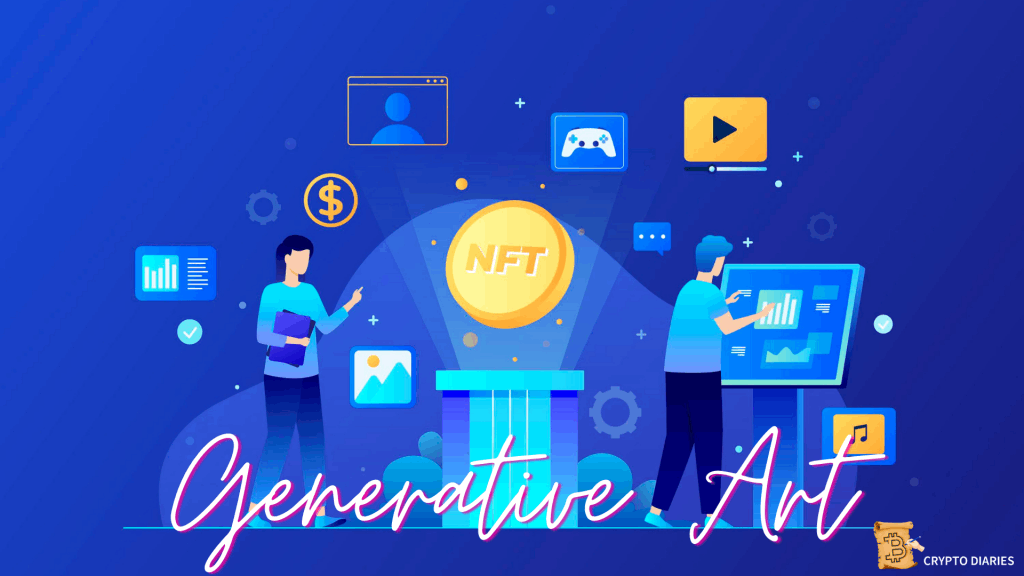Over the past few years, the NFT market has grown from a million-dollar industry to a billion-dollar industry. NFTs have generated billions of dollars in profit for artists and collectors. However, many of the works sold during this period were standard fare, such as paintings and digital reproductions of Old Masters done through iPad.
Since then, a new breed of artists started to experiment with the form and create art that was more closely tied to the digital world. One of the groups looked into the potential of an artistic format overlooked over time: generative art.
In this article, we’ll talk about the generative art NFTs concept, and you’ll determine whether they should be in your NFT collection.
Origin of Generative Arts
In the late eighteenth century, Mozart published Musikalisches Würfelspiel (German for “musical dice game”), a type of generative art that involved randomly creating music from pre-defined options.
Although this is an early example of generative art, blockchain technology has allowed for new opportunities to be created. One of these is running a smart contract stored on a blockchain, which can be triggered by sending crypto to an address. The code stored under this address is then executed automatically.
After a piece of generative art has been created by the smart contract, it can be stored on the blockchain as an NFT owned by the address that sent it.
What Is Generative Art?
Generative art brings life into the abstract imagination through non-human systems. It constantly tries to manipulate the possibilities of its creations. So, exactly what is this art form?
Generative art refers to works of art that an autonomous system has partially or wholly produced. That allows the system to determine the work’s features without the artist’s involvement. Programming language, computer programs, machines, and procedural inventions are some of the components that make up the autonomous system. Generative art can be audio or visual and utilize various types of media, such as 3D, virtual reality, and digital renderings that can be virtually displayed or installed in physical environments.
Generative art is autonomous since the artist does not directly control the system. That means the work’s brilliance is often valued without examining the underlying codes. Usually, generative minting involves running specific codes together and monitoring the resulting outputs to ensure they are good. After recognizing the algorithm’s good outcome, the artist codes the resulting output. An unwanted pattern can also be coded out of existence.
Hence, generative art comprises three major elements: geometry, algorithms, and randomness. Without these, the artist would have no choice but to decide the piece’s outcome in advance.
One thing stands out; the concept of generative art is a fundamental part of the art world, challenging the notion of value and creativity. It provides numerous possibilities for automated works of art with every program run.
What Are Generative Art NFTs?
A generative art NFT is a piece of art created through a smart contract and stored on-chain in NFT form. This process adds a uniqueness to the piece of art that previously had not been achieved by including the art’s transaction ID, wallet address, and gas price.
Notably, each piece of art is unique. Even if another piece of art is created that closely resembles the one created by the machine algorithm, the parameters used in the latter would still be different.
The emergence of AI-generated NFTs accentuates the potential for artists to collaborate with machines to create truly unique works.
One of the advantages of generative art is that it allows users to create a supply cap immediately. For instance, if a project has a predefined amount of NFTs, then only those that follow the same rules can be created.
Furthermore, due to the high entry borders and the complexity of the art market, the traditional market has been very exclusive. With the emergence of generative art, the market has opened up to a broader range of people who are not only art enthusiasts but also have lower investment budgets. That has led to the establishment of curated auctions focused on generative art. Some prominent auction houses, such as Christie’s and Sotheby’s, have also started putting generative art on their agenda.
Is There Real Value in NFTs for Generative Art?
Well, that does depend on the kind of value that we’re trying to measure. Digital artists should be able to access the market and monetize their work through NFTs. Based on the investments made in these works, there seems to be a speculative value in these pieces.
It’s also possible that the value of an artwork depends on the algorithm that generated it. For instance, artists might keep their copyright and reproduction rights to allow them to create new copies of their NFTs.
The algorithm that generated it is also important to consider when assessing an artwork’s value. It allows artists to create more copies of their work and differentiate themselves from other artists.
It’s also possible that the algorithm that generated it is not the owner of the artistic value. For instance, if you don’t own the training data and parameters of the model, you might not be able to assess the value of an artwork properly.
Top Generative Art NFT Projects
Due to technological advancements in the art world, pieces have become more complex and appealing. These new genres have allowed artists to create new art forms they had never thought of before. While everyone has their interpretation of art, these are some generative art projects that will catch your attention. Let’s get into it:
Art Blocks
Art Blocks is the digital platform that sells, produces, and stores on-demand generative art. It is one of the most successful generative art projects on the Ethereum blockchain. It was founded by Snowfro and is built on the Art Node smart contract. The thrill of the unknown is also part of the appeal of Art Blocks, as collectors can’t exactly predict what their piece will look like once it has been minted.
The Art Blocks platform has three categories: Curated, Factory, and Playground. The Curated section provides a curated selection of works representative of the highest levels of creativity and execution in crypto art. The platform’s Playground is a space where artists can explore what’s next for their projects.
Although Art Blocks doesn’t directly vet individual projects, the artists are vetted to ensure that their work is high quality. The Factory is a sort of space where artists can showcase their work.
Some notable Art Block projects are Chromie Squiggles, Fidenza, and Ringers.
Autoglyphs
Autoglyphs is regarded as the first generative art project that’s completely self-contained. The Larva Labs team behind CryptoPunks created the Glyphs in 2019. They were created by people willing to donate 0.2ETH to 350.org, a non-profit organization that fights climate change and promotes renewable energy sources. The creator of every glyph became the first owner, and the generator shut down after they made 512.
Unlike other generative art projects, Autoglyphs didn’t involve human intervention in creating their artworks. They were created using a completely autonomous algorithm. This project has since become one of the most significant innovations in the NFT industry.
Eponym
The Eponym collection is the world’s largest known collection of AI-generated art. It was created through Art AI, the world’s largest gallery of AI-generated art. Through its algorithms, users can create NFTs based on their choice of words or phrases.
Should You Invest in Generative Art NFTs?
Although generative art NFTs are still in their early stages of development, it’s still unclear what the future holds for them. However, history has shown that innovations such as Bitcoin and NFTs shouldn’t be sidelined. The total sales volume of these projects has already exceeded the initial expectations, which suggests that the potential of crypto art is immense.
The concept of generative art has been around for a long time, and the incorporation of NFTs makes it seem new. While it might take a minute before NFTs reach the success of projects such as Picasso, there is no denying that they have the potential to become a major innovation in the future.
However, before a person decides to purchase a generative art project, it’s important that they thoroughly research the market and its trends. Although generative art might seem like a different kind of asset from monkey-based NFTs, its values will still follow the trend of the crypto market and NFT trends.
Final Thoughts
Despite the history of generative art, the integration with NFTs has allowed it to breathe new life into it. Although it may take a while for generative art to reach the same level of success that other NFT initiatives have achieved, the 2021 explosion has shown that the promise of this type of art is still intact.
While the value of generative art has risen significantly, it is still important for collectors to thoroughly research the market before making a purchase. Although the price of this type of art has risen significantly, it is still expected to fluctuate in tandem with the other markets.

